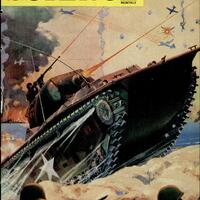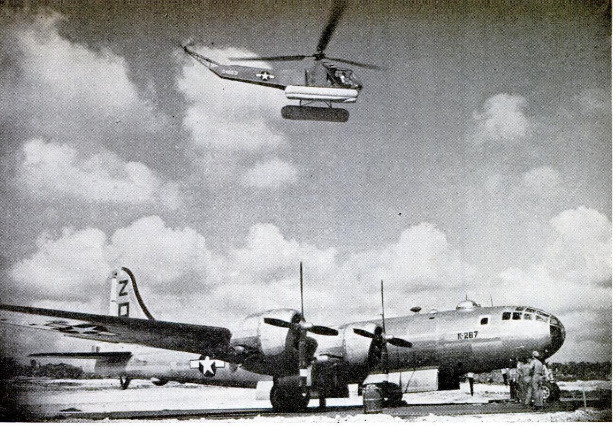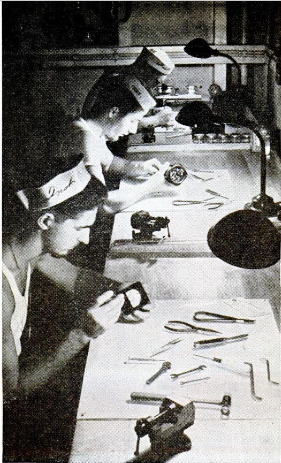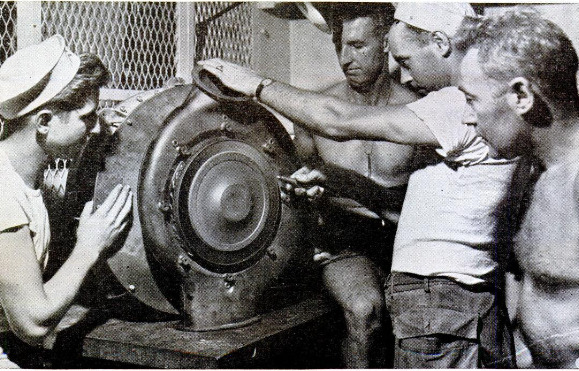-
Title (Dublin Core)
-
Seagoing shops keep the B-29's pounding Japan
-
Article Title and/or Image Caption (Dublin Core)
-
Title: Seagoing shops keep the B-29's pounding Japan
-
extracted text (Extract Text)
-
BY BRINGING the repair base to the Su-
perfortress, instead of vice versa, the
timetable of the Pacific war has been
speeded up two to six months. The Army
Air Forces now reveals another of its
schemes for blasting the Japs in their home-
lands—complete repair shops aboard Liberty
ships.
Those floating repair bases simply pull up
alongside a newly captured island and go
directly to work to keep the B-29's in tip-
top shape for their mighty bombing
attacks. They can do just about any-
thing in servicing the 55,000 parts of
the big planes. After there has been
time to establish repair bases on land,
the floating shops pull up anchor and
move on to the next island.
The Liberty ships, which were con-
verted to their mew use by the Air
Technical Service Command, are known
officially as Aircraft Repair Units
(Floating), but the seagoing AAF me-
chanics who work aboard them have
boiled it down to “floater.”
Not only is this new-type ship fitted
with such shops as are needed for its
mission, but it also is equipped with
quarters and mess facilities for its per-
sonnel work, intelligence officer, finance
officer, chaplain, laundry, PX, library,
movies, and a complete hospital.
Floaters carry their own local trans-
portation, for use at the scene of operations,
right on their backs. Perched above the
forward portion of the main deck is a 72-
by-40-foot flight deck from which Sikorsky
R-4B helicopters operate. Just aft of the
flight deck are two “ducks” and two jeeps
with trailers. On the fantail are two 30-
foot work boats.
Here's how the floater works: When B-29
operations began in Saipan last November,
the planes were experiencing trouble with
their prop governor heads. A clip which
held a resistor was defective. The vibra-
tion of the engines loosened the clip, and
the resistor, which looks like a cartridge-
type fuse, popped out of the clip, got into
the moving parts of the governor, and some-
times ripped it to pieces.
One of the floaters arrived in Saipan the
day before the first Tokyo raid, and dropped
anchor in Garapan harbor. Tactical outfits at
Iseley Field rushed some 50 damaged prop
governor heads to it for repair. Working
at top speed, robbing some of the beat-up
‘mechanisms for parts, and improvising, the
men of the floater that night had a number
of governor heads in serviceable condition.
The repair units are equipped with the
following shops: machine shop, welding,
sheet metal, heat treating, electroplating,
ordnance, turret, ground and airborne radar,
radio, camera repair, propeller, carburetor,
turbo-supercharger, electrical, paint-dope-
and-fabric, woodwork, instrument, bomb-
sight, tire, fuel cell, parachute rigging, and
drafting. There is a plant for the generation
of aviators’ breathing oxygen, the largest
mobile plant of this kind overseas.
The B-29's aren't the only customers. The
floaters have done work on P-51's and can
handle work from any other planes, Army
or Navy. One outfit even manufactured
some gears for Seabee bulldozers when the
Seabees were in a jam, and another capped
the tires of a general's staff car.
-
Contributor (Dublin Core)
-
Amos Landman (article writer)
-
Language (Dublin Core)
-
eng
-
Date Issued (Dublin Core)
-
1945-09
-
pages (Bibliographic Ontology)
-
91-92
-
Rights (Dublin Core)
-
Public domain
-
Archived by (Dublin Core)
-
Sami Akbiyik
 Popular Science Monthly, v. 147, n. 3, 1945
Popular Science Monthly, v. 147, n. 3, 1945






